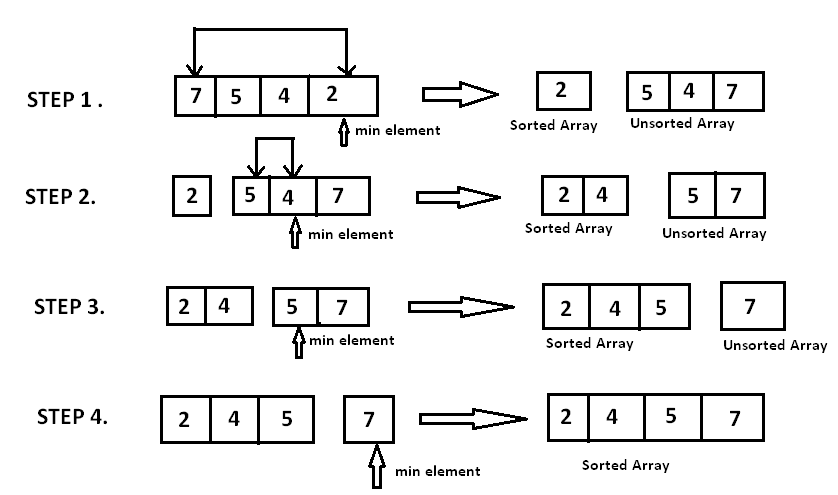Sorting/Searching Algorithms - Sorting Lesson
Categories: Sorting/Searching AlgorithmsA lesson on sorting algorithms for AP Computer Science students.
Sorting Algorithms
Big O Notation:
- Measures how fast algorithms run as input size grows
- Shows worst-case performance scenario
- Ignores constants and focuses on growth rate
- Common notations:
- O(1): Constant time (same speed regardless of input size)
- O(log n): Logarithmic (gets slightly slower with larger inputs)
- O(n): Linear time (speed directly proportional to input size)
- O(n log n): Common in efficient sorting algorithms
- O(n²): Quadratic time (common in nested loops)
- O(2ⁿ): Exponential time (very slow for large inputs)
- Helps compare efficiency of different algorithms
- Used to make decisions about which algorithm to implement
1. Selection Sorting
Selection sort methodically builds the sorted list by repeatedly finding and placing the smallest remaining element.
- Finds the smallest element in the unsorted portion
- Swaps it with the first unsorted element
- Repeats until the entire list is sorted
- Makes fewer swaps than bubble sort

public class SelectionSort {
public static void main(String[] args) {
int[] list = {28, 12, 18, 8, 30, 3, 17, 14};
System.out.println("Sorting process:");
for (int currentIndex = 0; currentIndex < list.length - 1; currentIndex++) {
int minIndex = currentIndex;
// Find the minimum element in the unsorted part
for (int i = currentIndex + 1; i < list.length; i++) {
if (list[i] < list[minIndex]) {
minIndex = i;
}
}
// Swap the current element with the minimum element
int temp = list[currentIndex];
list[currentIndex] = list[minIndex];
list[minIndex] = temp;
// Print the array after each swap
printArray(list);
}
System.out.println("\nFinal sorted list:");
printArray(list);
}
// Helper method to print the array
private static void printArray(int[] array) {
for (int num : array) {
System.out.print(num + " ");
}
System.out.println();
}
}
SelectionSort.main(new String[]{});
Sorting process:
3 12 18 8 30 28 17 14
3 8 18 12 30 28 17 14
3 8 12 18 30 28 17 14
3 8 12 14 30 28 17 18
3 8 12 14 17 28 30 18
3 8 12 14 17 18 30 28
3 8 12 14 17 18 28 30
Final sorted list:
3 8 12 14 17 18 28 30
2. Insertion Sorting
Insertion sort mimics how we naturally sort items like playing cards by building the sorted list one element at a time.
- Builds the sorted list one item at a time
- Takes each element and inserts it into its correct position among already sorted elements
- Works well for small data sets or nearly sorted data
- Similar to how people typically sort playing cards

Code Example:
public class InsertionSort {
public static void main(String[] args) {
int[] list = {28, 12, 18, 8, 30, 3, 17, 14};
System.out.println("Sorting process:");
// Insertion sort algorithm
for (int i = 1; i < list.length; i++) {
int currentValue = list[i];
int j = i - 1;
// Shift larger elements to the right
while (j >= 0 && list[j] > currentValue) {
list[j + 1] = list[j];
j--;
}
// Place the current value in the correct position
list[j + 1] = currentValue;
// Print the list after each insertion
for (int k = 0; k < list.length; k++) {
System.out.print(list[k] + " ");
}
System.out.println(); // New line after each pass
}
// Final sorted list
System.out.println("Sorted array:");
for (int num : list) {
System.out.print(num + " ");
}
}
}
InsertionSort.main(new String[]{});
Sorting process:
12 28 18 8 30 3 17 14
12 18 28 8 30 3 17 14
8 12 18 28 30 3 17 14
8 12 18 28 30 3 17 14
3 8 12 18 28 30 17 14
3 8 12 17 18 28 30 14
3 8 12 14 17 18 28 30
Sorted array:
3 8 12 14 17 18 28 30
